Performance Characteristics of the Battery-Operated Silicon PIN Diode Detector with an Integrated Preamplifier and Data Acquisition Module for Fusion Particle Detection
Abstract
1. Introduction
2. Detector System Design
3. Signal Analysis Method and Results
3.1. Am-241 Calibration
3.2. Effect of Gamma Rays on Si PIN Detector
4. Data Acquisition Module
Operation in Vacuum
5. Conclusions
6. Patents
Author Contributions
Funding
Data Availability Statement
Acknowledgments
Conflicts of Interest
References
- Chen, A.X.; Liu, N.-W.; Gunn, A.; Su, Z.; Sigal, B.F.; Salazar, M.; Abdalla, N.; Chen, J.; Wong, A.Y.; Wang, Q. Compact Ion Beam System for Fusion Demonstration. Phys. Open 2024, 21, 100234. [Google Scholar] [CrossRef]
- Magee, R.M.; Ogawa, K.; Tajima, T.; Allfrey, I.; Gota, H.; McCarroll, P.; Ohdachi, S.; Isobe, M.; Kamio, S.; Klumper, V.; et al. First measurements of p11B fusion in a magnetically confined plasma. Nat. Commun. 2023, 14, 955. [Google Scholar] [CrossRef]
- Ramirez-Jimenez, F.J.; Mondragon-Contreras, L.; Cruz-Estrada, P. Application of PIN diodes in Physics Research. AIP Conf. Proc. 2006, 857, 395–406. [Google Scholar] [CrossRef]
- Ramirez-Jimenez, F.J.; Aguilera, E.F.; Lopez-Callejas, R.; Benitez-Read, J.S.; Pacheco-Sotelo, J. A novel application of a PIN diode-preamplifier set for the measurement of charged particles. Nuc. Instr. Meth. Phys. Res. A 2005, 545, 721–726. [Google Scholar] [CrossRef]
- Gál, N.; Hrubčín, L.; Šagátová, A.; Vanko, G.; Kováčová, E.; Za’ko, B. High-resolution alpha-particle detector based on Schottky barrier 4H-SiC detector operated at elevated temperatures up to 500 °C. Appl. Surf. Sci. 2023, 635, 157708. [Google Scholar] [CrossRef]
- Hamamatsu Large-Area Si PIN Photodiode for Direct Radiation Detection. Available online: https://www.hamamatsu.com/us/en/product/optical-sensors/photodiodes/si-photodiodes/S14605.html (accessed on 12 May 2025).
- Energizer A23 Battery Data Sheet. Available online: https://data.energizer.com/pdfs/a23.pdf (accessed on 12 May 2025).
- Amptek A250 Charge Sensitive Preamplifier Application Note. Available online: https://www.amptek.com/internal-products/a250-charge-sensitive-preamplifier-application-note (accessed on 12 May 2025).
- Riegler, W. Particle Detectors—Summer Student Lectures 2010. Available online: https://indico.cern.ch/event/91742/attachments/1096757/1564539/L5_solid_calo_pid_riegler.pdf (accessed on 12 May 2025).
- OPA167x Low-Distortion Audio Operational Amplifiers. Available online: https://www.ti.com/lit/ds/symlink/opa1678.pdf (accessed on 12 May 2025).
- ADP7182 −28 V, −200 mA, Low Noise, Linear Regulator. Available online: https://www.analog.com/en/products/adp7182.html (accessed on 12 May 2025).
- Linear Regulators (LDO)|NCP160, LDO Regulator, 250 mA, Ultra-High PSRR, Ultra-Low Noise. Available online: https://www.onsemi.com/products/power-management/linear-regulators-ldo/ncp160 (accessed on 12 May 2025).
- Duracell CR123A Lithium/Manganese Dioxide Battery Data Sheet. Available online: https://www.duracell.com/wp-content/uploads/2021/06/CR123_US.pdf (accessed on 12 May 2025).
- Picoscope 5000 Series—Flexible Resolution USB Oscilloscope. Available online: https://www.picotech.com/oscilloscope/5000/flexible-resolution-oscilloscope (accessed on 12 May 2025).
- Ramirez-Jimenez, F.J.; Lopez-Callejas, R.; Cerdeira-Altuzarra, A.; Benitez-Read, J.S.; Estrada-Cueto, M.; Pacheco-Sotelo, J.O. PIN diode-preamplifier set for the measurement of low-energy g- and X-rays. Nuc. Instr. Meth. Phys. Res. A 2003, 497, 577–583. [Google Scholar] [CrossRef]
- Ziegler, J.F. SRIM-2003. Nuc. Instr. Meth. Phys. Res. Sec. B 2004, 219–220, 1027–1036. [Google Scholar] [CrossRef]
- Stave, S.; Ahmed, M.W.; France, R.H., III; Henshaw, S.S.; Müller, B.; Perdue, B.A.; Prior, R.M.; Spraker, M.C.; Weller, H.R. Understanding the B11 (p, α) αα reaction at the 0.675 MeV resonance. Phys. Lett. B 2011, 696, 26–29. [Google Scholar] [CrossRef]
- Klein, O.; Nishina, Y. Über die Streuung von Strahlung durch freie Elektronen nach der neuen relativistischen Quantendynamik von Dirac. Z. Physik 1929, 52, 853–868. [Google Scholar] [CrossRef]
- Industrial Fiber Optics, Inc. Available online: https://i-fiberoptics.com/ (accessed on 12 May 2025).


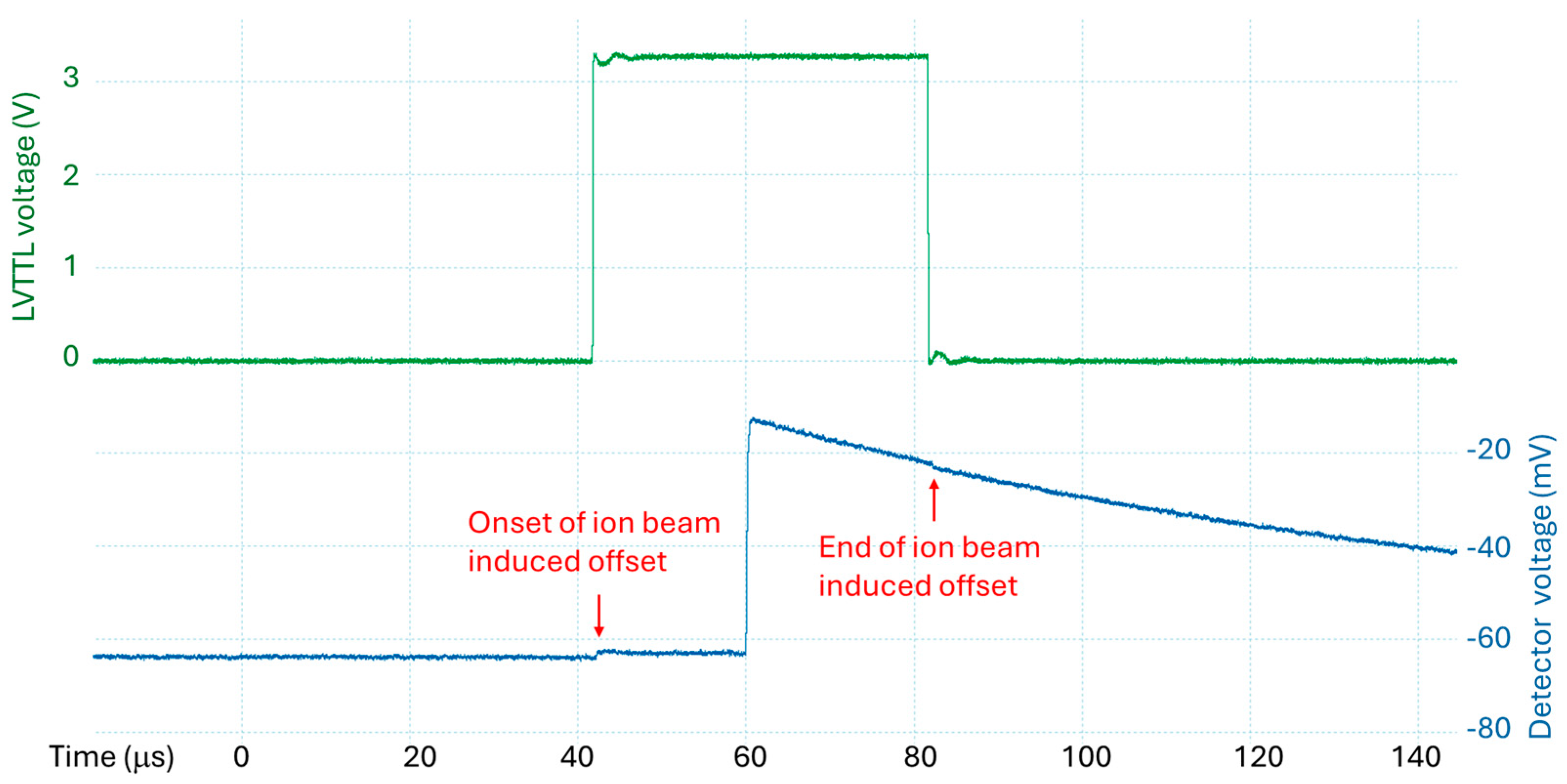
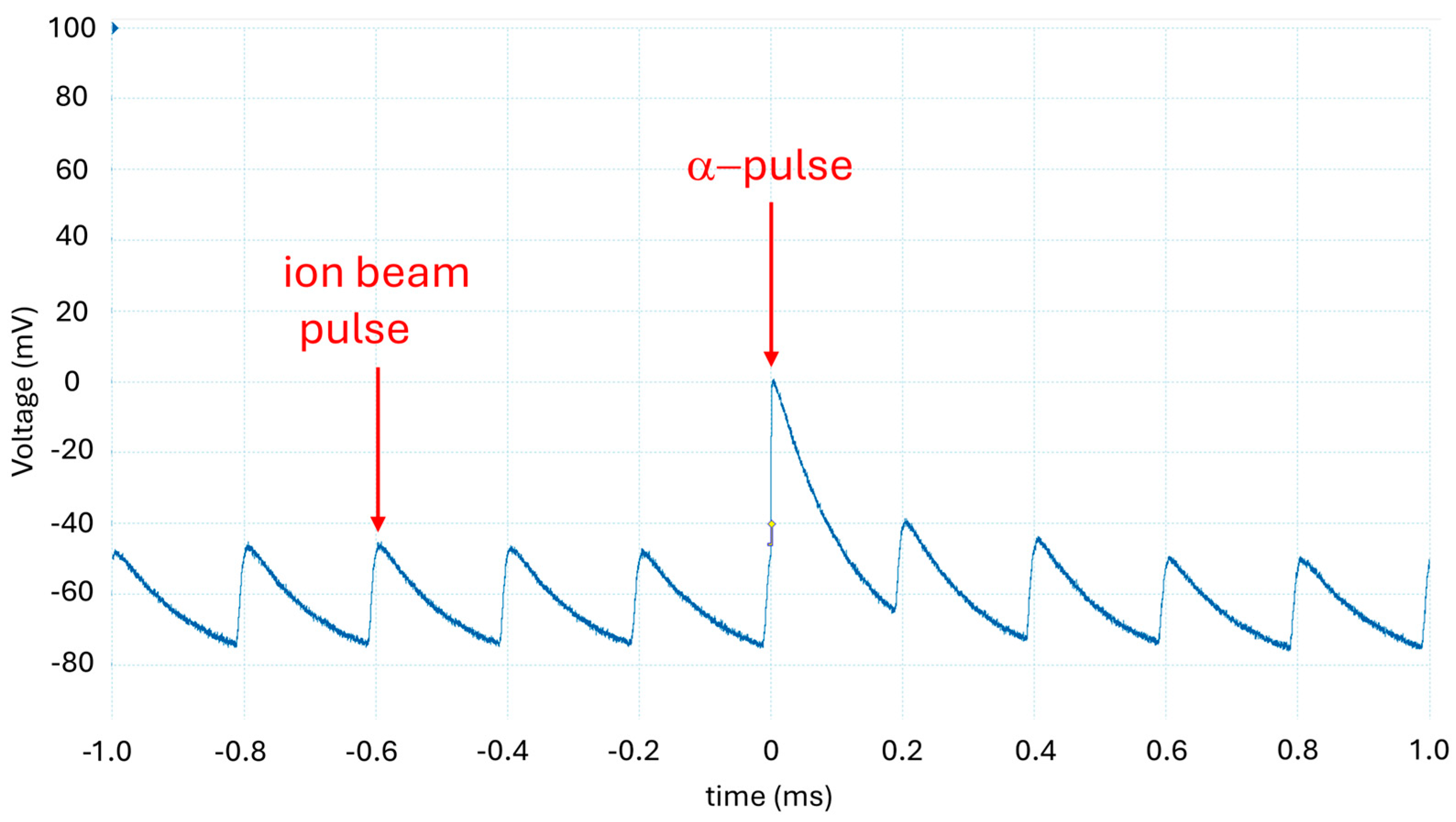
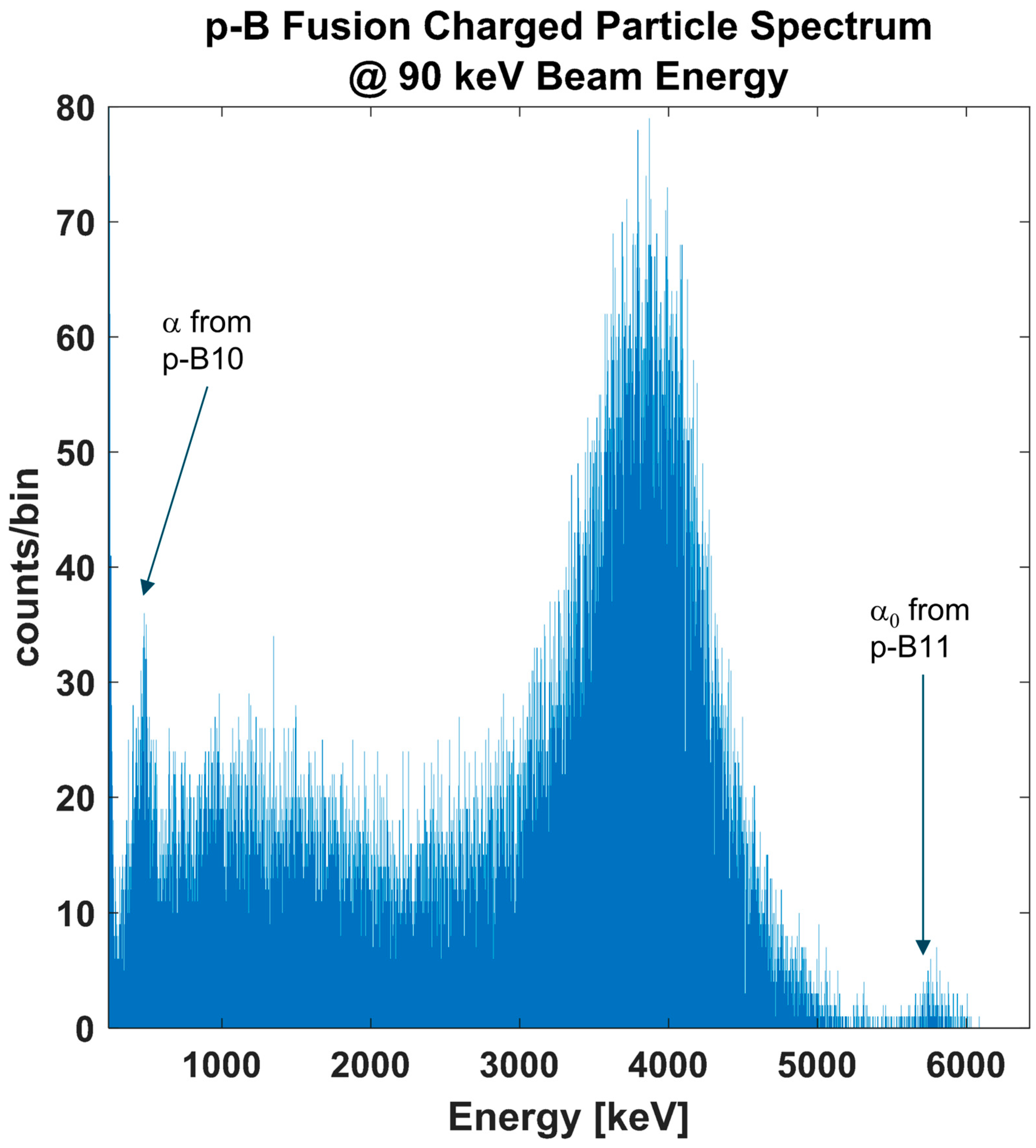
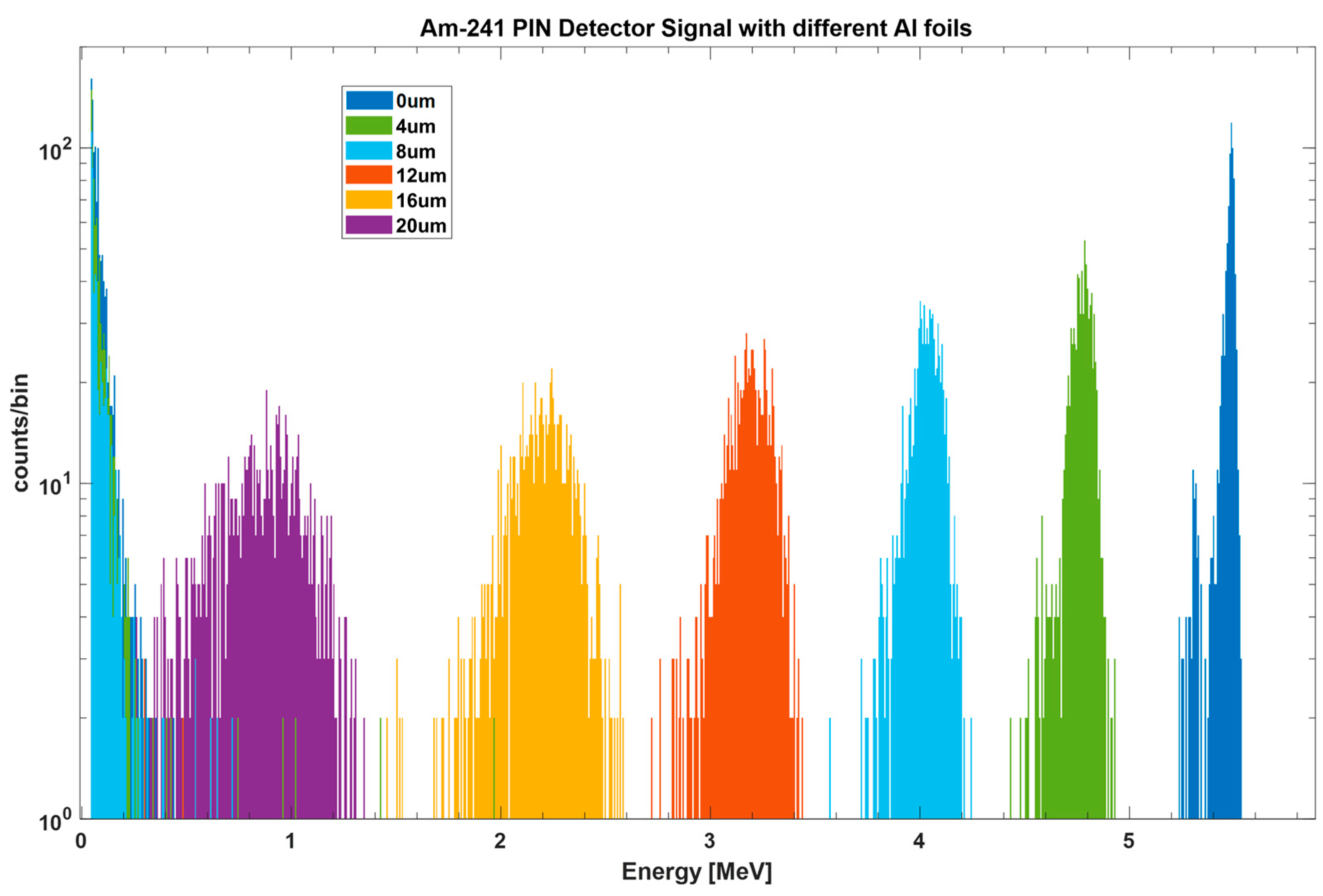

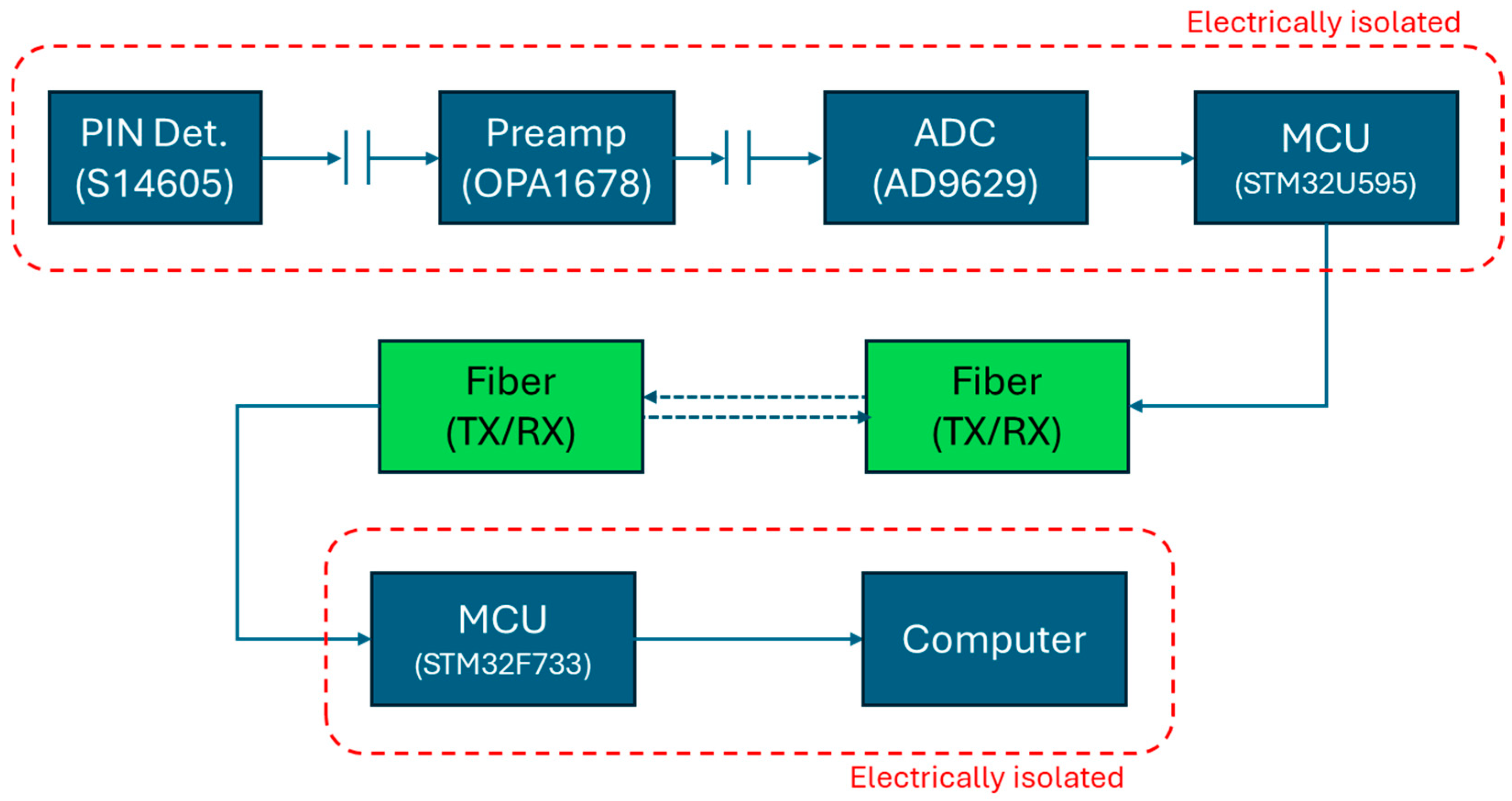
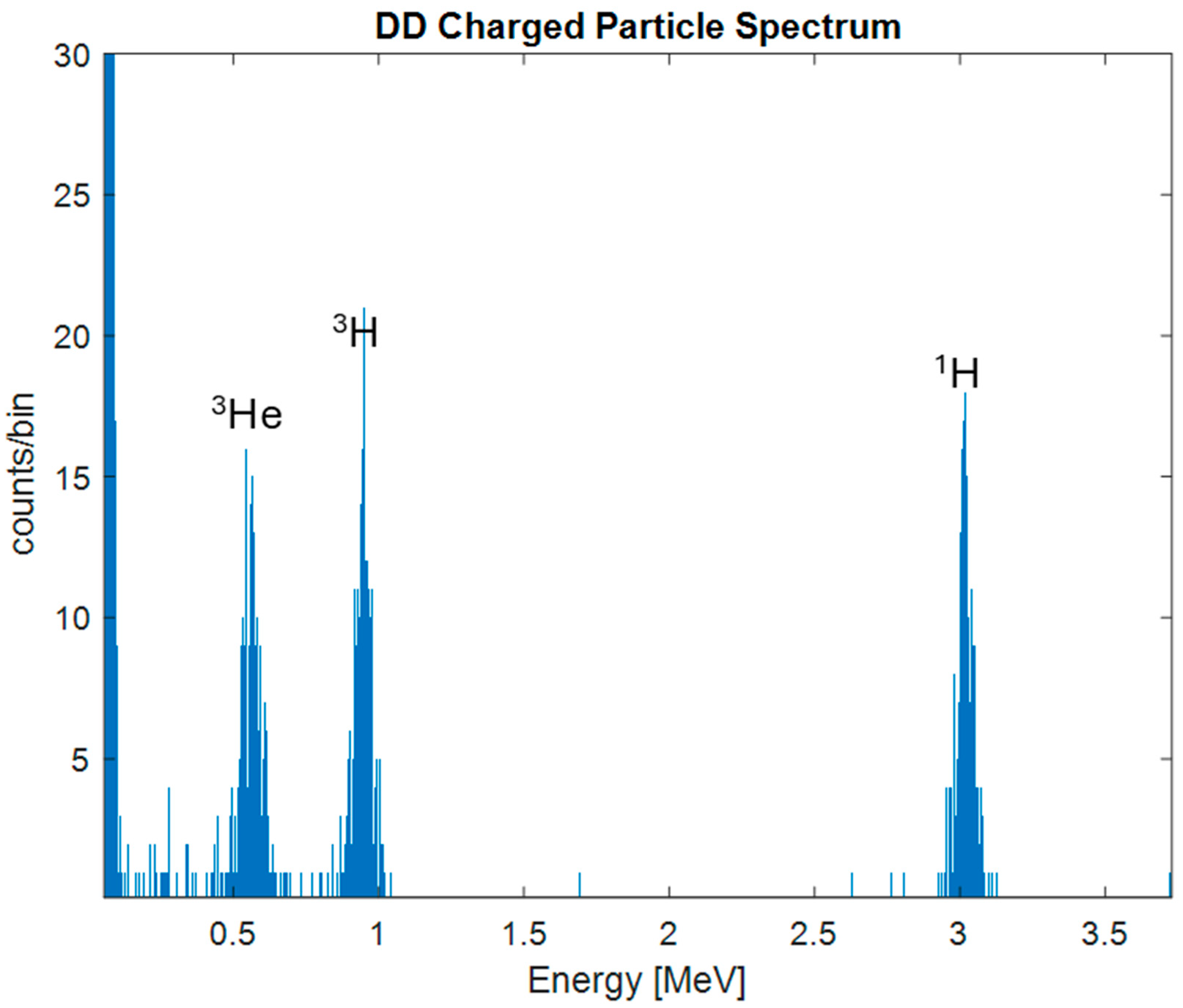
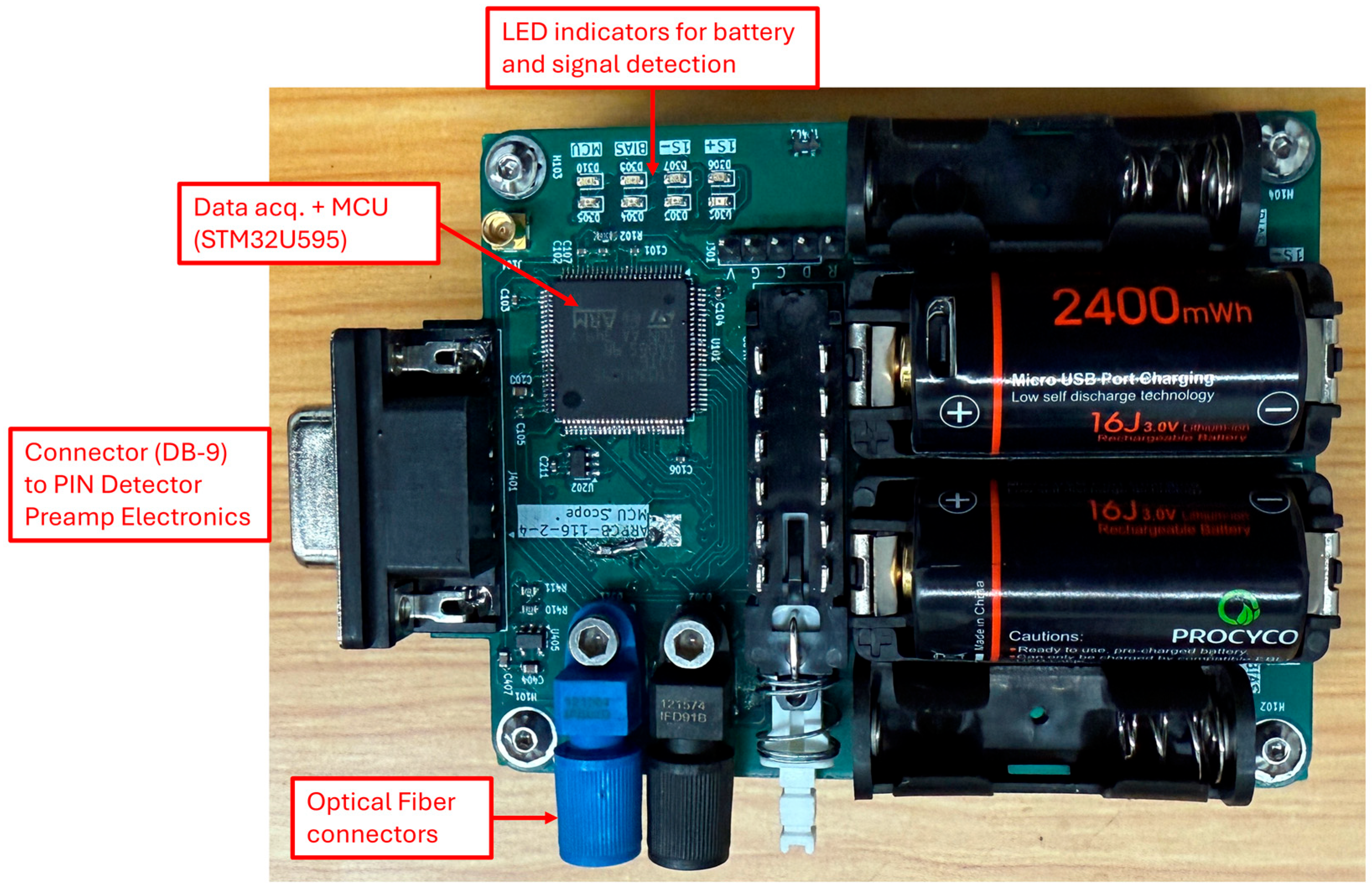
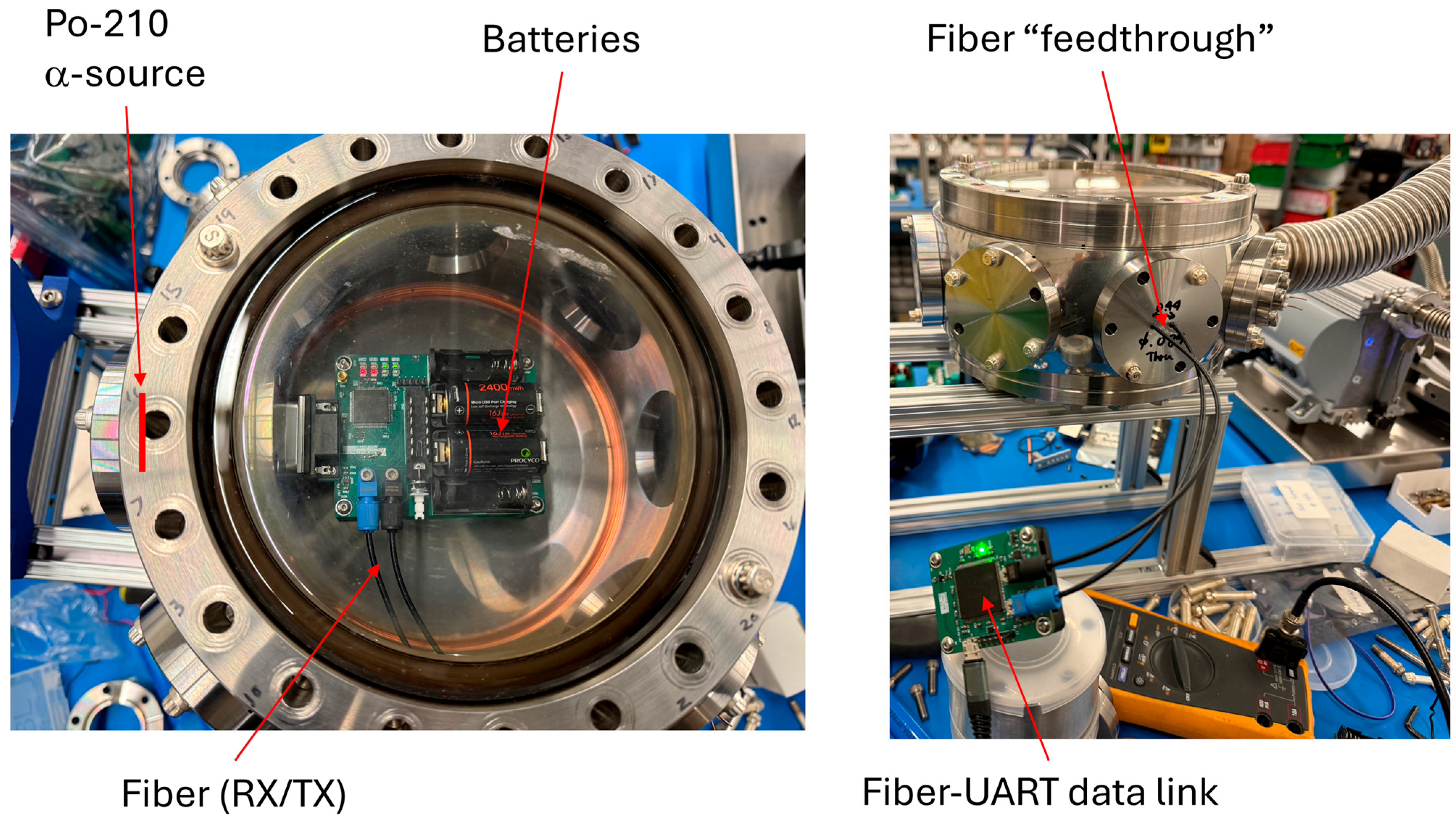
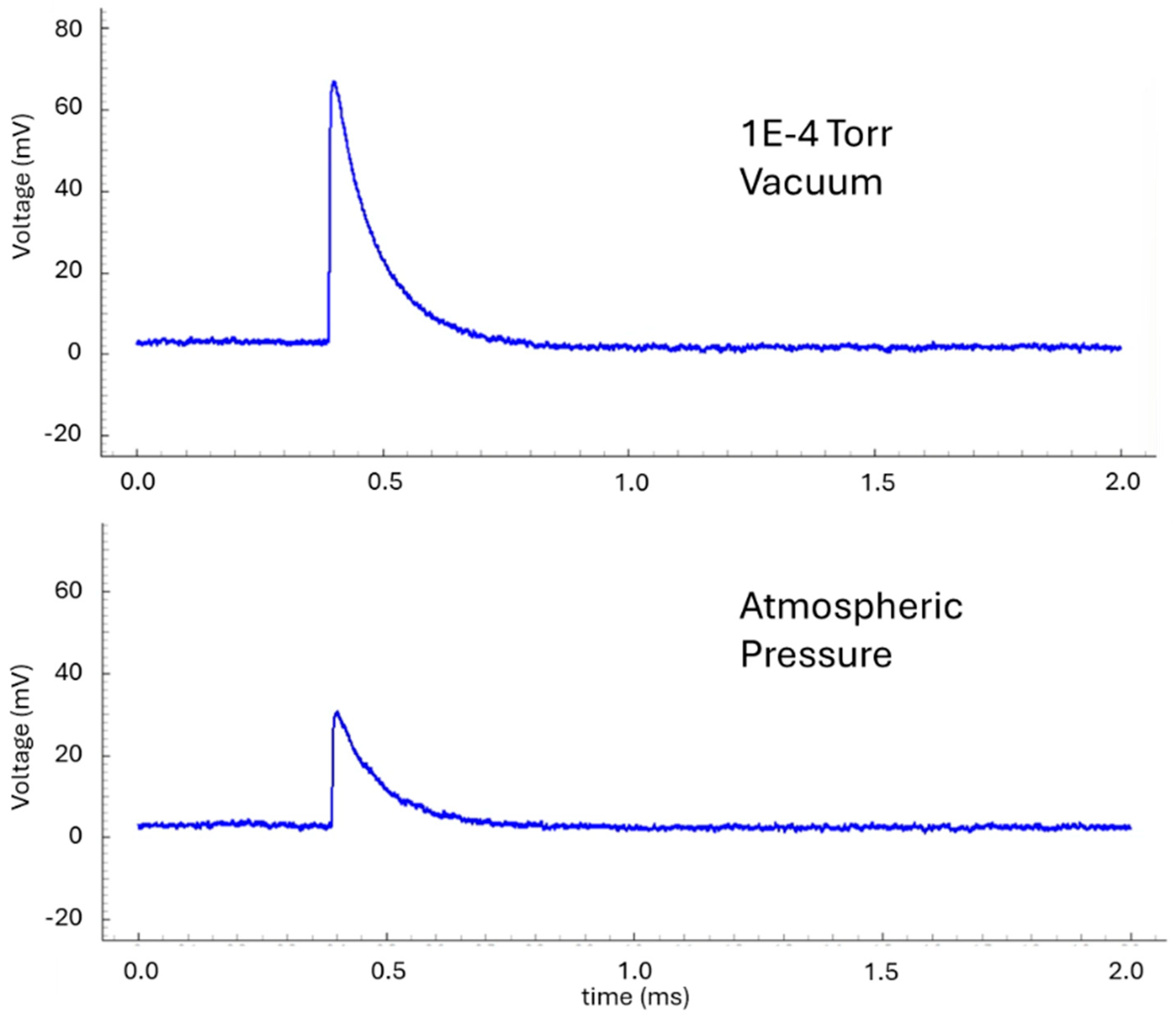
| Foil Thickness [μm] | Peak Energy (SRIM) | Peak Energy (Edge-Cal) |
|---|---|---|
| 0 | 5.486 | 5.486 |
| 4 | 4.814 | 4.858 |
| 8 | 4.151 | 4.165 |
| 12 | 3.373 | 3.394 |
| 16 | 2.479 | 2.571 |
| 20 | 1.397 | 1.315 |
Disclaimer/Publisher’s Note: The statements, opinions and data contained in all publications are solely those of the individual author(s) and contributor(s) and not of MDPI and/or the editor(s). MDPI and/or the editor(s) disclaim responsibility for any injury to people or property resulting from any ideas, methods, instructions or products referred to in the content. |
© 2025 by the authors. Licensee MDPI, Basel, Switzerland. This article is an open access article distributed under the terms and conditions of the Creative Commons Attribution (CC BY) license (https://creativecommons.org/licenses/by/4.0/).
Share and Cite
Chen, A.X.; Sigal, B.F.; Martinis, J.; Wong, A.Y.; Gunn, A.; Salazar, M.; Abdalla, N.; Xiao, K.-J. Performance Characteristics of the Battery-Operated Silicon PIN Diode Detector with an Integrated Preamplifier and Data Acquisition Module for Fusion Particle Detection. J. Nucl. Eng. 2025, 6, 15. https://doi.org/10.3390/jne6020015
Chen AX, Sigal BF, Martinis J, Wong AY, Gunn A, Salazar M, Abdalla N, Xiao K-J. Performance Characteristics of the Battery-Operated Silicon PIN Diode Detector with an Integrated Preamplifier and Data Acquisition Module for Fusion Particle Detection. Journal of Nuclear Engineering. 2025; 6(2):15. https://doi.org/10.3390/jne6020015
Chicago/Turabian StyleChen, Allan Xi, Benjamin F. Sigal, John Martinis, Alfred YiuFai Wong, Alexander Gunn, Matthew Salazar, Nawar Abdalla, and Kai-Jian Xiao. 2025. "Performance Characteristics of the Battery-Operated Silicon PIN Diode Detector with an Integrated Preamplifier and Data Acquisition Module for Fusion Particle Detection" Journal of Nuclear Engineering 6, no. 2: 15. https://doi.org/10.3390/jne6020015
APA StyleChen, A. X., Sigal, B. F., Martinis, J., Wong, A. Y., Gunn, A., Salazar, M., Abdalla, N., & Xiao, K.-J. (2025). Performance Characteristics of the Battery-Operated Silicon PIN Diode Detector with an Integrated Preamplifier and Data Acquisition Module for Fusion Particle Detection. Journal of Nuclear Engineering, 6(2), 15. https://doi.org/10.3390/jne6020015







